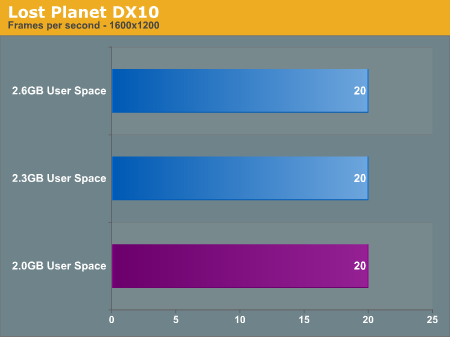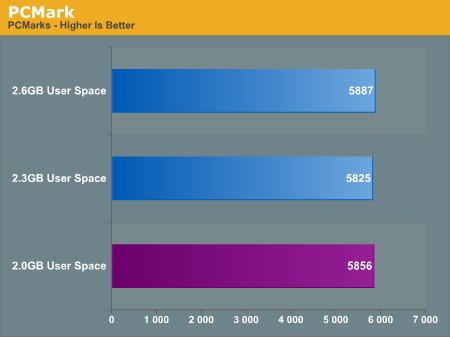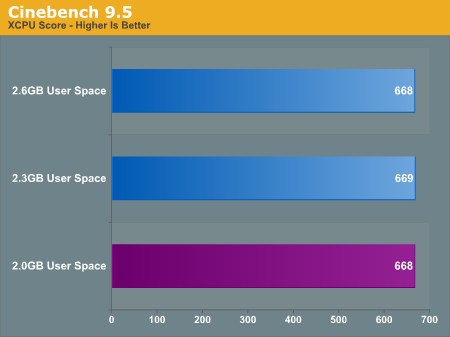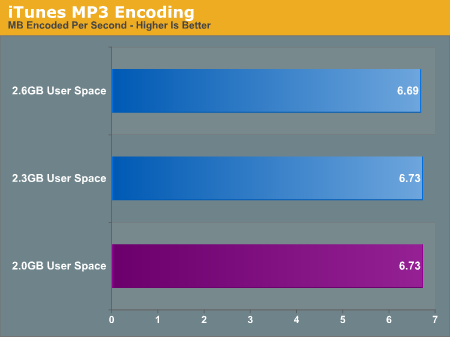A Messy Transition: Practical Problems With 32bit Addressing In Windows
by Ryan Smith on July 12, 2007 12:00 PM EST- Posted in
- Software
Now that we've seen what can happen when we reach the 2GB barrier and how easy it can be to pass it, let's talk about what it took to remove it in the first place for Supreme Command. Supreme Commander is unfortunately not compiled as being large address aware and must be modified so that Windows thinks that it is. Microsoft supplies a tool as part of the Visual Studio suite, Editbin, that can do just this by rewriting the file header to report to Windows that it is in fact large address aware.
To the best of our knowledge Supreme Commander was programmed using proper programming practices and can handle the larger address space, and this is merely an issue of turning it on. However on a more pragmatic note this can break future patches, and disturbingly it doesn't set off any sort of multiplayer cheat detection in the game in spite of the fact that we have modified the executable in a very visible way. Out of the changes we need to make to deal with the 2GB barrier though, this is the safer of the two.
Update: Gas Powered Games contacted us and let us know that the modified executable not setting off any cheat detection is intentional. The game code is all in a DLL, and the executable is just a launcher; it's left unchecked because of the various Digital Rights Management systems used change the exectuable.
Changing Windows on the other hand to allocate more of the virtual address space to applications is in practice just as dangerous as we theorized earlier. We initially set our copy of Windows Vista to adjust the split to 1GB kernel mode, 3GB user mode, only for Vista to encounter a BSOD while booting. We had to settle for a 1.4GB/2.6GB split before Vista would boot, and even then Vista still periodically encounters a BSOD upon booting at that allocation or any other allocation other than 2GB/2GB. While what problems may occur and with what values is highly variable from system to system, this is why trying to move the barrier at all can be dangerous.
Having made the above changes, we also used the chance to take a look at system performance both in and outside of Supreme Commander, taking interest in to the effect of allocating more user mode space. As we theorized before, taking space away from the kernel may impact performance, and this is something that needs to be tested. For this we ran a cut-down version of our normal system test suite, with allocations of 1.4GB/2.6GB, 1.7GB/2.3GB, and the default 2GB/2GB.
| Software Test Bed | |
| Processor | AMD Athlon 64 4600+ (2x2.4GHz/512KB Cache, S939) |
| RAM | OCZ EL Platinum DDR-400 (4x512MB) |
| Motherboard | ASUS A8N-SLI Premium (nForce 4 SLI) |
| System Platform Drivers | NV 15.00 |
| Hard Drive | Maxtor MaXLine Pro 500GB SATA |
| Video Cards | 1 x GeForce 8800GTX |
| Video Drivers | NV ForceWare 158.45 |
| Power Supply | OCZ GameXStream 700W |
| Desktop Resolution | 1600x1200 |
| Operating System | Windows Vista Ultimate 32-Bit |
| . | |

Starting with Supreme Commander, the only test here that can even utilize more than 2GB of user space, we do find a minor but consistent variation in performance. Increasing the user space improved Supreme Commander performance by about 1 frame per second, which at around a 3.5% performance improvement is right along the edge of either being significant or a normal variation. We repeated this test several times just to make sure that it wasn't a variation and the results remained consistent, so it doesn't appear to be a variation. With that said the instability caused by adjusting the user space size does not justify the extremely minor performance improvement.





Going down the list of benchmarks, we find that there is no notable change in performance in any of our benchmarks. Since none of these benchmarks are capable of using more user space we weren't expecting an increase, but this puts to rest the idea of a performance decrease. There does not appear to be a performance decrease in adjusting the user space size; if it boots it'll perform well.










69 Comments
View All Comments
nullpointerus - Thursday, July 12, 2007 - link
64bit versions of Windows(i.e. XP and Vista) do not suffer from the traditional 2GB barrier, as all the kernel mode addressing is usually moved to well above the confines of the limited 32bit addressing area. As such, these versions of Windows don't need to have their space allocations adjusted for an application to gain access to more addressing space, bypassing the instability and any possible performance problems that occurs as a result of making this adjustment.I used 64-bit Vista for a while but just couldn't deal with the BSOD's and other wierd behavior that would happen with 4 GB RAM installed and the BIOS memory hole option set. For example, the nVidia SATA drivers (3 updates on Windows Update alone) for my board would BSOD on every boot when the BIOS memory hole option was enabled, and the PVR-150's driver would randomly corrupt itself and turn into a green/garbled slideshow:
http://www.hauppauge.co.uk/board/showthread.php?t=...">http://www.hauppauge.co.uk/board/showthread.php?t=...
I wish the 64-bit driver developers would get off their butts and fix this stuff.
gersson - Thursday, July 12, 2007 - link
Large Address Aware Statusit says, "STALKER: Oblivion Lost"
Ryan Smith - Thursday, July 12, 2007 - link
I'm not sure I see what the problem is. Could you go in to more detail?gersson - Thursday, July 12, 2007 - link
You meant to place 'Stalker' cos there is already an entry for oblivion and 'lost' (I assume you mean 'lost planet')Read like this:
Observe first line:
STALKER: Oblivion Lost Yes
Lost Planet No
Company of Heroes Yes
Supreme Commander No
Enemy Territory: Quake Wars Yes
Battlefield 2142 No
Call of Juarez DX10 BM No
World of Warcraft No
The Elder Scrolls IV: Oblivion No
Photoshop CS3 Yes
Dreamweaver CS3 No
DigitalFreak - Thursday, July 12, 2007 - link
No. Stalker had the working title of Stalker: Oblivion Lost...gersson - Thursday, July 12, 2007 - link
hmm ok, didn't know that -- but you can see how I had arrived @ my conclusion :-PThe Boston Dangler - Thursday, July 12, 2007 - link
the game was released as STALKER: Shadow of Chernobyl. no biggieRyan Smith - Thursday, July 12, 2007 - link
Fixed. I keep forgetting they changed the name.grant2 - Thursday, July 12, 2007 - link
So this game will crash reproducably when using a large map, with many players, and many units.And GPG released it like this? Either their QA department is rather incompetent, or management were buffoons to ignore such an obvious error.
Very disapointing!
EODetroit - Thursday, July 12, 2007 - link
I've been hoping Anandtech would take memory issues more seriously for a while now, glad you're getting your teeth into it for real now!"Unfortunately Windows Vista reverted to a non-accelerated desktop at this point, preventing us from capturing a screenshot of the exact memory readouts or the error message."
Use a camera!